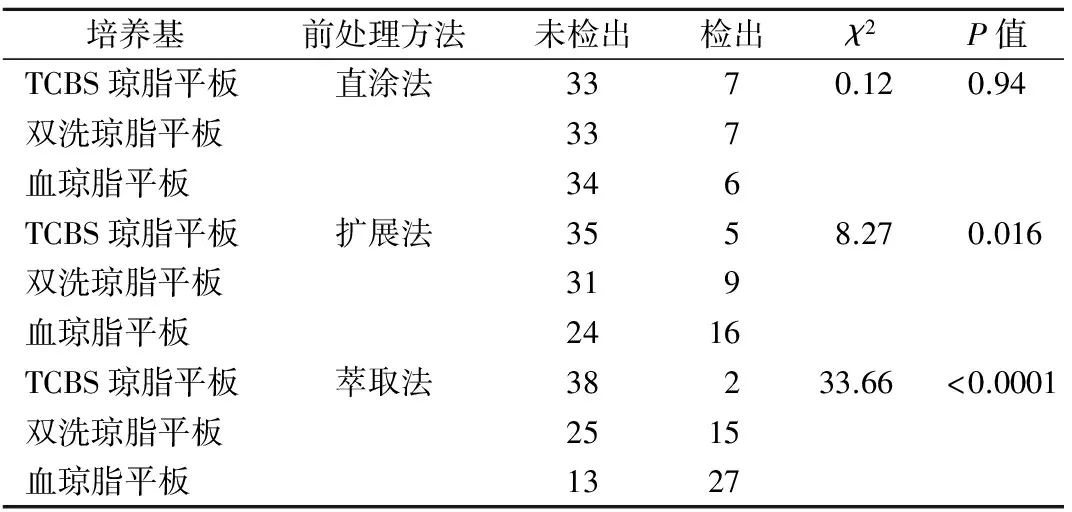不同培养基与前处理方法对副溶血弧菌MALDI-TOF MS鉴定结果的影响评估
2017-05-25陈峰张丹丽宛宝山陈晋同济大学附属上海市肺科医院检验科上海200433上海交通大学医学院附属新华医院a检验科环境与儿童健康实验室上海200092
陈峰,张丹丽,宛宝山,陈晋(.同济大学附属上海市肺科医院检验科,上海 200433;2.上海交通大学医学院附属新华医院a.检验科,b.环境与儿童健康实验室,上海 200092)
·临床检验技术研究·
不同培养基与前处理方法对副溶血弧菌MALDI-TOF MS鉴定结果的影响评估
陈峰1,2a,张丹丽2b,宛宝山1,陈晋1
(1.同济大学附属上海市肺科医院检验科,上海 200433;2.上海交通大学医学院附属新华医院a.检验科,b.环境与儿童健康实验室,上海 200092)
目的 评估不同培养基及前处理方法在基质辅助激光解吸电离飞行时间质谱(MALDI-TOF MS)对副溶血弧菌鉴定中的影响,并寻求最优化条件组合。方法 收集副溶血弧菌40株,分别用血琼脂平板、TCBS琼脂平板和双洗琼脂平板进行培养;用直涂法、扩展法(直涂后裂解)和萃取(裂解、萃取后涂靶)法进行质谱前处理。用SAS软件建立不同培养基及前处理方法对该菌质谱检出率影响的logistic回归分析模型,并进行卡方检验统计分析。结果 “血琼脂平板+萃取法”条件组合检出率最高(100%鉴定到属,67.5%鉴定到种);在不使用血琼脂平板的前提下,“双洗琼脂平板+萃取法”条件组合检出率最高(70%鉴定到属,37.5%鉴定到种)。在“属”鉴定水平,前处理方法相同时,不同培养基的检出率差异有统计学意义(P<0.01);而培养基相同时,不同前处理方法的检出率差异无统计学意义(P>0.05);直涂法和扩展法相对萃取法的相对危险度(OR)分别为0.66和0.95,检出率差异无统计学意义(P>0.05);TCBS琼脂平板和双洗琼脂平板相对血琼脂平板的OR分别为0.06和0.10,对检出率差异有统计学意义(P<0.05),logistic回归方程Y=2.95-0.41a-0.05b-2.83c-2.35d(a:直涂法;b:扩展法;c:TCBS琼脂平板;d:双洗琼脂平板)。在“种”鉴定水平,采用扩展法或萃取法,不同培养基的检出率差异有统计学意义(P<0.05);采用血琼脂平板,不同前处理方法的检出率差异有统计学意义(P<0.01);直涂法和扩展法相对萃取法的OR分别为0.32和0.55,检出率差异有统计学意义(P<0.05);TCBS琼脂平板和双洗琼脂平板相对血琼脂平板的OR分别为0.18和0.49,检出率差异有统计学意义(P<0.05),logistic回归方程Y=0.20-1.15a-0.61b-1.72c-0.72d(a:直涂法;b:扩展法;c:TCBS琼脂平板;d:双洗琼脂平板)。结论 欲提升副溶血弧菌MALDI-TOF MS鉴定效果,合适培养基的选择优于改善蛋白质提取的前处理操作。推荐萃取法作为常规前处理方法,培养基的选择建议依次为血琼脂平板、双洗琼脂平板和TCBS琼脂平板。
培养基;前处理方法;基质辅助激光解吸电离飞行时间质谱;副溶血弧菌
基质辅助激光解吸电离时间飞行时间质谱(matrix-assisted laser desorption/ionization time-of-flight mass spectrometry,MALDI-TOF MS)技术具有快速、准确、敏感性高、高通量等特点,已常规应用于细菌和真菌的鉴定[1-2]。当鉴定效果不佳时,处理方案往往集中在提高蛋白质提取效率[3]、样本离心富集[4]等优化前处理方法上。一旦上述方案对于某些菌株仍没有奏效,往往束手无策。副溶血弧菌的临床质谱鉴定往往直接挑取选择性培养基上的菌落,并且副溶血弧菌在TCBS琼脂平板、双洗琼脂平板和血琼脂平板上的菌落特征呈现粘稠度依次降低,乳化性逐渐上升,差异明显。故本研究选取该菌种,评估质谱鉴定过程中2个较常见的实验条件(培养基和前处理方法)对其鉴定结果的影响,并寻求最优组合方案。
1 材料和方法
1.1 菌株来源 收集2016年1月至12月上海交通大学医学院附属新华医院临床患者粪便标本来源的副溶血弧菌分离株40株,-80 ℃保存菌种。所有菌株均经16S rDNA测序[5]鉴定,与NCBI比对符合率大于99%。
1.2 主要试剂与仪器 甲酸、乙腈和三氟乙酸(美国Sigma-Aldrich公司);IVD细菌测试标准品、α-氰基-4-羟基肉桂酸(HCCA)、96孔金属靶板、Biotyper 3.0鉴定分析软件MicroflexTM和MALDI-TOF MS仪(德国 Bruker Daltonik公司);血琼脂平板(上海伊华医学公司);硫代硫酸盐柠檬酸盐胆盐蔗糖琼脂培养基琼脂平板(thiosulfate citrate bile salts sucrose agar culture medium,TCBS)、双洗琼脂平板或链霉素月桂基硫酸钠亚碲酸钾琼脂平板(double wash agar plate, or streptomycin sodium lauryl sulfate potassium tellurite agar plate)和菌种保存管(上海科玛嘉微生物公司);PCR试剂盒(上海生工公司);PCR仪(德国Eppendorf公司);BigDye Terminator v3.1测序试剂盒与ABI 310型全自动DNA测序仪(美国Applied Biosystems公司)。
1.3 不同培养基的培养 将收集的40株副溶血弧菌自菌种保存管接种至血琼脂平板,35 ℃培养24 h。取复苏后单个菌落分别转种至血琼脂平板、TCBS琼脂平板和双洗琼脂平板于35 ℃培养24 h行次代培养。
1.4 质谱分析前处理方法 由具有3年以上熟练操作Bruker公司MALDI Biotyper经验的人员完成前处理及质谱鉴定工作。直涂法:直接涂菌于靶板孔位;扩展法:在直涂法的基础上,取1 μL 70%甲酸水溶液对靶板上的细菌进行裂解,并室温干燥;萃取法:挑取菌落至含300 μL去离子水的离心管,加入900 μL乙醇,混匀后20 817×g离心2 min,沉淀以50 μL 70%的甲酸水溶液裂解细菌菌体,并加入50 μL乙腈萃取蛋白10 min,15 000 r/min离心2 min,取1 μL上清液点样至96孔金属靶板,室温干燥。
1.5 MS鉴定 加1 μL HCCA于上述3种不同前处理方法得到靶板上的样品表面,室温干燥,进样至MALDI-TOF MS系统中分析。IVD 细菌测试标准品用于每一块金属靶板质谱分析前的仪器参数校正。参数设置:线性,正离子,蛋白质峰谱质荷比(m/z)范围2 000 至20 000,激光解吸每孔至少240次。应用Biotyper 3.0鉴定分析软件,显示前十位鉴定结果。记录排名第一位的鉴定结果和质谱评分(MALDI score),并根据Bruker Dahonics公司的Microflex MALDI-TOF MS鉴定结果3分制标准(分值2.000~3.000:鉴定结果“种”水平可信;分值1.700~1.999:鉴定结果“属”水平可信;分值≤1.699:鉴定结果不可信)对鉴定结果可信度进行解读。
1.6 统计学分析 采用SAS 9.4软件进行数据整理及统计分析。不同培养基与前处理方法下“属”、“种”水平鉴定结果比较用卡方检验和logistic回归分析。以P<0.05为有统计学意义。
2 结果
2.1 不同培养基及前处理方法组合对副溶血弧菌鉴定率的比较 40株副溶血弧菌经不同的培养基与前处理方法组合的检出率中“血琼脂平板+萃取法”条件组合最高,“属”和“种”水平的检出率分别为100%和67.5%;在不使用血琼脂平板的前提下,“双洗琼脂平板+萃取法”条件组合检出率最高,“属”和“种”水平的检出率分别为70%和37.5%。见表1。

表1 “属、种”水平的检出率(%)
注:鉴定到“属”水平的数据中包括鉴定到“种”水平的数据。
2.2 不同培养基与前处理方法对“属”水平鉴定结果影响 对“属”水平鉴定,前处理方法相同时,不同培养基的检出率差异有统计学意义(P<0.05),见表2;培养基相同时,不同前处理方法的检出率差异无统计学意义(P>0.05),见表3。不同前处理方法与培养基对“属”水平检出率影响进行logistic回归分析,以萃取法和血琼脂平板作为参照,logistic回归方程为Y=2.95-0.41a-0.05b-2.83c-2.35d(a:直涂法;b:扩展法;c:TCBS琼脂平板;d:双洗琼脂平板);直涂法和扩展法相对萃取法的相对危险度(OR)分别为0.66和0.95,检出率差异无统计学意义(P>0.05);TCBS琼脂平板和双洗琼脂平板相对于血琼脂平板的OR分别为0.06和0.10,检出率的差异有统计学意义(P<0.05)。

表2 不同培养基对“属”水平检出率的影响
2.3 不同培养基与前处理方法对“种”水平鉴定结果影响 对“种”水平鉴定,采用直涂法,不同培养基的检出率差异无统计学意义(P>0.05);采用扩展法,不同培养基的检出率差异有统计学意义(P<0.05);采用萃取法,不同培养基的检出率差异有统计学意义(P<0.01)。见表4。不同前处理方法对“种”水平鉴定结果影响仅体现在固定选用血琼脂平板时,不同前处理方法的选择对于检出率差异有统计学意义(P<0.01)。见表5。

表4 不同培养基对“种”水平检出率的影响

表5 不同前处理方法对“种”水平检出率的影响
不同前处理方法与培养基对“种”水平检出率影响进行logistic回归分析,以萃取法和血琼脂平板作为参照,logistic回归方程为Y=0.20-1.15a-0.61b-1.72c-0.72d(a:直涂法;b:扩展法;c:TCBS琼脂平板;d:双洗琼脂平板)。直涂法和扩展法相对萃取法的OR分别为0.32和0.55,检出率的差异有统计学意义(P<0.05);TCBS琼脂平板和双洗琼脂平板相对血琼脂平板的OR分别为0.18和0.49,检出率的差异有统计学意义(P<0.05)。
3 讨论
对于质谱鉴定,不同培养基培养会导致菌株肽质量谱有所变化[6]。本研究表明,使用MALDI-TOF MS鉴定副溶血弧菌时,合适培养基的选择优于改善蛋白质提取效率的操作。在“属”水平,3种琼脂平板的检出率依次为血琼脂平板>双洗琼脂平板≥TCBS琼脂平板,而采用不同的前处理方法来提高蛋白质提取程度并未提升副溶血弧菌的检出率。在“种”水平,3种前处理方法的检出率顺序依次为萃取法>扩展法>直涂法,3种琼脂平板的检出率依次为血琼脂平板>双洗琼脂平板≥TCBS琼脂平板。查阅Biotyper 3.0鉴定分析软件数据库,副溶血弧菌建库条件组合即为“血琼脂平板+萃取法”,亦是佐证了本研究的结论。
影响质谱结果的因素众多[7],培养基的选择仅是上机前影响因素之一。本研究亦存在不足之处,如样本量偏少,菌种范围单一;纳入研究的菌株尽管进行了测序确认,但未深究分子水平的型别不同(包括标准菌株)是否会否造成蛋白质表达量差异;不同人员操作结果的重复性如何等等。以上因素需要进一步的研究。就本文结果,结合临床实际工作,提出以下建议:对副溶血弧菌的质谱分析,应以萃取法作为常规前处理方法;临床微生物实验室对疑似副溶血弧菌进行质谱鉴定结果不佳时,不妨考虑将菌种转种至血琼脂平板进行4 h的短时培养[8];考虑到副溶血弧菌的培养不以血琼脂平板为初代培养基,且在此前提下“双洗琼脂平板+萃取法”条件组合具有最高的检出率,故建议以MALDI-TOF MS作为主要鉴定手段的实验室考虑将在用的TCBS琼脂培养基替换为双洗琼脂培养基;诸如疾病预防控制中心等部门,或是行批量的副溶血弧菌质谱分析,建议将菌种传代至血琼脂平板培养;对质谱仪的厂方,建议开发出更新的菌种蛋白质指纹图谱数据库,其培养条件更能贴近临床一线实际使用情况,或是对数据库进行分层(基本数据库、科研数据库),数据库仍存在改进的空间[9];一线工作人员应增强对MALDI-TOF MS在临床微生物鉴定中常见问题的了解,并能熟练选择合适的对策[10],提升质谱技术的应用效果。
[1]Bizzini A, Greub G. Matrix-assisted laser desorption ionization time-of-flight mass spectrometry, a revolution in clinical microbial identification[J]. Clin Microbiol Infect, 2010, 16(11): 1614-1619.
[2]戴颖欣, 李敏. MALDI-TOF MS在临床微生物检验中的应用[J]. 检验医学, 2015, 30(2): 102-107.
[3]Park JS, Choi SH, Hwang SM,etal. The impact of protein extraction protocols on the performance of currently available MALDI-TOF mass spectrometry for identification of mycobacterial clinical isolates cultured in liquid media[J]. Clin Chim Acta, 2016, 460: 190-195.
[4]March-Rossello GA, Munoz-Moreno MF, Garcia-Loygorri-Jordan de Urries MC,etal. A differential centrifugation protocol and validation criterion for enhancing mass spectrometry(MALDI-TOF) results in microbial identification using blood culture growth bottles[J]. Eur J Clin Microbiol Infect Dis, 2013, 32(5): 699-704.
[5]Devereux R, Wilkinson SS. Amplification of ribosomal RNA sequences[M].G.A. Kowalchuk, F.J. de Brujin, I.M. Head, A.D.L. Akkermans, J.D. van Elsas. Molecular microbial ecology manual. 2nd ed. Dordrecht: Kluwer Academic, 2004: 509-522.
[6]Valentine N, Wunschel S, Wunschel D,etal. Effect of culture conditions on microorganism identification by matrix-assisted laser desorption ionization mass spectrometry[J]. Appl Environ Microbiol, 2005, 71(1): 58-64.
[7]中国临床微生物质谱共识专家组. 中国临床微生物质谱应用专家共识[J]. 中华医院感染学杂志, 2016, 26(10): I-V.
[8]Haigh J D, Green I M, Ball D,etal. Rapid identification of bacteria from bioMerieux BacT/ALERT blood culture bottles by MALDI-TOF MS[J]. Br J Biomed Sci, 2013, 70(4): 149-155.
[9]Erler R, Wichels A, Heinemeyer E A,etal. VibrioBase: A MALDI-TOF MS database for fast identification of Vibrio spp. that are potentially pathogenic in humans[J]. Syst Appl Microbiol, 2015, 38(1): 16-25.
[10]李修远, 黄艳飞, 尚军, 等. MALDI-TOF-MS在临床微生物鉴定中的常见问题及对策[J]. 临床检验杂志, 2016, 34(12): 885-891.
(本文编辑:周万青,刘群)
Effects of different culture media and pretreatment methods on the results of MALDI-TOF mass spectrometry for the identification ofVibrioparahaemolyticus
CHENFeng1,2a,ZHANGDan-li2b,WANBao-shan1,CHENJin1
(1.DepartmentofClinicalLaboratory,ShanghaiPulmonaryHospitalAffiliatedtoTongjiUniversity,Shanghai200433; 2.a.DepartmentofClinicalLaboratory,b.MinistryofEducation-ShanghaiKeyLaboratoryofChildren′sEnvironmentalHealth,XinhuaHospital,ShanghaiJiaoTongUniversitySchoolofMedicine,Shanghai200092,China)
Objective To investigate the effects of different culture media and pretreatment methods on the results of matrix-assisted laser desorption ionization time-of-flight mass spectrometry(MALDI-TOF MS) for the identification ofVibrioparahaemolyticus, and then provide the optimal conditions. Methods Forty strains ofVibrioparahaemolyticuswere collected, and subcultured with the blood agar plate, thiosulfate citrate bile salts sucrose(TCBS) agar plate and double wash agar plate, respectively. The pretreatment methods before mass spectrometry included the smear method, extension method and extraction method. The effects of different culture media and pretreatment methods on the results of MALDI-TOF MS for the identification ofVibrioparahaemolyticuswere analyzed by the logistics regression model and Chi-square test of SAS software. Results The detection rate ofVibrioparahaemolyticuswas the highest in the combination of blood agar plate with the extraction method(genus level: 100%; species level: 67.5%), followed by the combination of double wash agar plate with the extraction method(genus level: 70%; species level: 37.5%). For the genus identification level ofVibrioparahaemolyticus, when the pretreatment method was the same, different culture media produced significantly different detection rates(P<0.01). However, when the culture medium was the same, there was no significant difference in detection rates for different pretreatment methods(P>0.05). The odd ratios(OR) of the smear method and extention method relative to the extraction method were 0.66 and 0.95, respectively, and there was no significant difference in detection rates for them(P>0.05), while the ORs of the TCBS agar plate and double wash agar plate relative to blood agar plate were 0.06 and 0.10, respectively, and there was significant difference in detection rates for them(P<0.05). The logistic regression equation wasY=2.95-0.41a-0.05b-2.83c-2.83d(a: smear method; b: extension method; c: TCBS agar plate; d: double wash agar plate). For the species identification level ofVibrioparahaemolyticus, when the extension method or the extraction method was used, different culture media produced significantly different detection rates(P<0.05). When the blood agar plate was used, different pretreatment methods also produced significantly different detection rates(P<0.01). The ORs of the smear method and extention method relative to the extraction method were 0.32 and 0.55, respectively, and there was significant difference in detection rates for them(P<0.05), while the ORs of the TCBS agar plate and double wash agar plate relative to blood agar plate were 0.18 and 0.49, respectively, and there was significant difference in detection rates for them(P<0.05). The logistic regression equation wasY=0.20-1.15a-0.61b-1.72c-1.72d(a: smear method; b: extension method; c: TCBS agar plate; d: double wash agar plate). Conclusion For improving the detection rate ofVibrioparahaemolyticusby MALDI-TOF MS, the selection of appropriate culture medium is more important than that of the pretreatment method. It is recommended that the extraction method may be as a conventional pretreatment method, and that the optimal medium is the blood agar plate, followed by the double wash agar plate and TCBS agar plate.
culture medium; pretreatment method; MALDI-TOF MS;Vibrioparahaemolyticus
10.13602/j.cnki.jcls.2017.04.07
陈峰,1981年生,男,大学本科,主管技师,从事微生物检验工作;张丹丽,1991年生,女,硕士,从事数据分析工作。两位对本文贡献等同,共为第一作者。
陈晋,E-mail:chenjindor@gmail.com。
R446.5
A
2017-01-02)
